The Fulbridge Academy Music Room Project – The Cavern……….
4.1 – 10.6.16
The Brief
I know I’ve said this before, and I’m certain I will say it again, but this was a most demanding and challenging project, perhaps the most complex and involved mural proposal I’ve been involved with. Even before I’d completed the Fulbridge ‘Sistine Chapel‘ project Principal Iain Erskine had invited me to return to the school to paint another mural. This time the location was to be the music room, recently renamed The Cavern, and my brief was to transform the appearance of an ordinary classroom into an inspirational and stimulating music workspace.




Children from nursery age through to year 6 engage with music in this venue, and I would be working in the room while lessons continued as normal. This was to be a new experience even for Fulbridge Academy and I was very conscious about being a disturbance and invading the space of Music Co-Ordinator Phil Duff. Nevertheless, from the very beginning, Phil was very accepting of the prospect of a painting gradually appearing on the walls as he continued to lead his music workshops, and that vote of confidence gave me much peace of mind.
Iain’s first thoughts were to suggest an approach similar to the ‘Champions of Humanity‘ corridor mural I painted in 2012 but which this time might intimate the appearance of a Music History ‘Timeline’. The first thoughts in my mind’s eye envisaged a radical change in both the atmosphere and appearance of the room, which would conjure more the feeling of a music venue or studio than what might be perceived as a traditional classroom.
It was an exciting prospect and following a first meeting with both Iain and Phil I retired to my studio where I spent several weeks engaged in research and to develop some design ideas. I’ve always had a particular love for music in all its forms and this brief felt like a gift sent from heaven!
However I also knew it would be a very difficult and tricky problem to solve too, that in order to present the many and various complexities of the history of the subject serious editing would be required, causing the omission of more personalities than I could possibly include. As well as the face to face and email conversations with Iain and Phil, Academy staff were also asked to offer suggestions and a list containing both the familiar and the very unusual began to evolve and take shape. Nonetheless, the research and consideration stage of this brief created an almost insoluble dilemma, prompting the design to undergo many alterations and modifications.
The Design
An early influence for the design in terms of how I might piece the individual ingredients together was a mural in Dixie’s Bar of Music in New Orleans painted by Xavier Gonzalez, however as I began making my first scribbles I was reminded of the paintings and drawings of David Oxtoby I’d first seen almost 40 years ago. I could also picture the flamboyant portraits produced by Sidney Maurer as inspiration too. Eventually I settled on the idea of producing a mural that might reflect the pages of a scrapbook that was forever being updated, but instead of the surface being paper it would have the appearance of bare brick in the same way the original Cavern Club in Liverpool looked in the early sixties.
I was determined that as many genres of musical style as possible would be represented and also that the selection wouldn’t be overloaded with personalities from the more recent past. There needed to be a consideration for a mix of gender and culture, to acknowledge the voice as an instrument and to recognise the legacy of enigmatic performers as well as that of composers.




It goes without saying that everyone could make a different final selection, but it might be prudent to explain some of my decisions. In addition there is another underlying back story to the selections which raises not only a point of concern but a warning, that a career in the creative arts can also expose frailties very damaging to individual well being. (To begin with, surviving beyond the age of 27 is a very important hurdle, an extraordinary number of musicians have succumbed at that age). Music as an artform has left with it a wonderful history for us all to enjoy, but as an industry it is absolutely littered with casualties.
It was alarming to take note of how many people from the world of music actually died during this project. In the week before I started painting Lemmy Kilmister of Motorhead, The Specials’ drummer John Bradbury and jazz singer Natalie Cole died, and during the time I spent working in the room itself David Bowie, Glenn Frey (The Eagles), Black, Maurice White (Earth, Wind & Fire), indie rock band Viola Beach, George Martin, Keith Emerson, Andy Newman (Thunderclap Newman), Prince, Billy Paul and Dave Swarbrick (Fairport Convention), to name but a few, departed too.



The Selection
(Following each selection I’ve included a youtube weblink so that a flavour of each Cavern inductee can be sampled directly)






As the room now goes by the name of The Cavern, The Beatles had to be included but I felt their image needed to reflect their early years when like a tsunami wave they changed the musical landscape as well as the mindset of a generation. Michael Jackson and Miles Davis are placed to each side of the Cavern stage. I’ve always compared Miles Davis as an equivalent to Picasso in the world of jazz, who throughout his career was consistently imaginative and innovative, constantly reinventing his chosen genre and nurturing the careers of others, and the same description could be applied to Michael Jackson. As the list of possible protagonists for this project lengthened, my method of selection was to seek out ‘Signposts’ and not ‘Weather Vanes’. This wall is a perfect example of that premise as each could be described as an incomparable giant. In their particular field there can be no doubt that these figures were leaders and others followed in their wake.
(The Beatles – Some Other Guy – The Cavern 1962)
(Michael Jackson – Smooth Criminal 1987)
(Miles Davis – So What 1959)
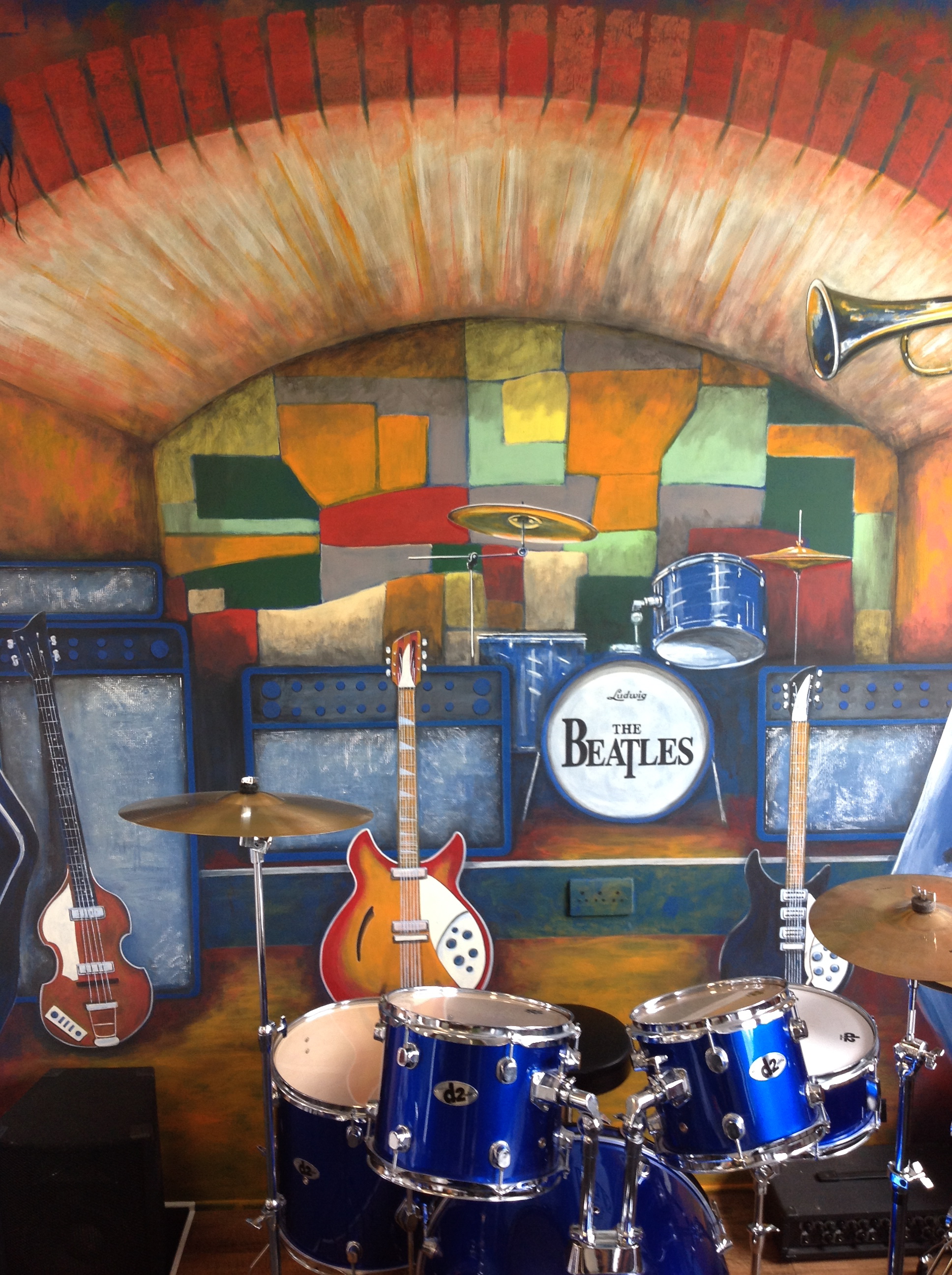
The only wall that had any pre-determined plan was that facing all visitors when entering the room which would become The Cavern stage, a focal point with a raised platform being added upon which potential musicians and singers could perform. Iain asked for instruments to be included so that it might suggest that the Fab Four could be waiting in the wings ready to play. On the left is Paul McCartney‘s Hofner Bass, George Harrison‘s 1963 Rickenbacker 360/12 in the centre and John Lennon‘s Rickenbacker 325 Capri to the right. The small drumkit is based upon a photograph taken of Pete Best playing in the Cavern Club, who was the Beatles’ drummer from August 1960 until August 1962 when Ringo Starr replaced him.
(A Walk Inside The Cavern, Mathew Street, Liverpool)
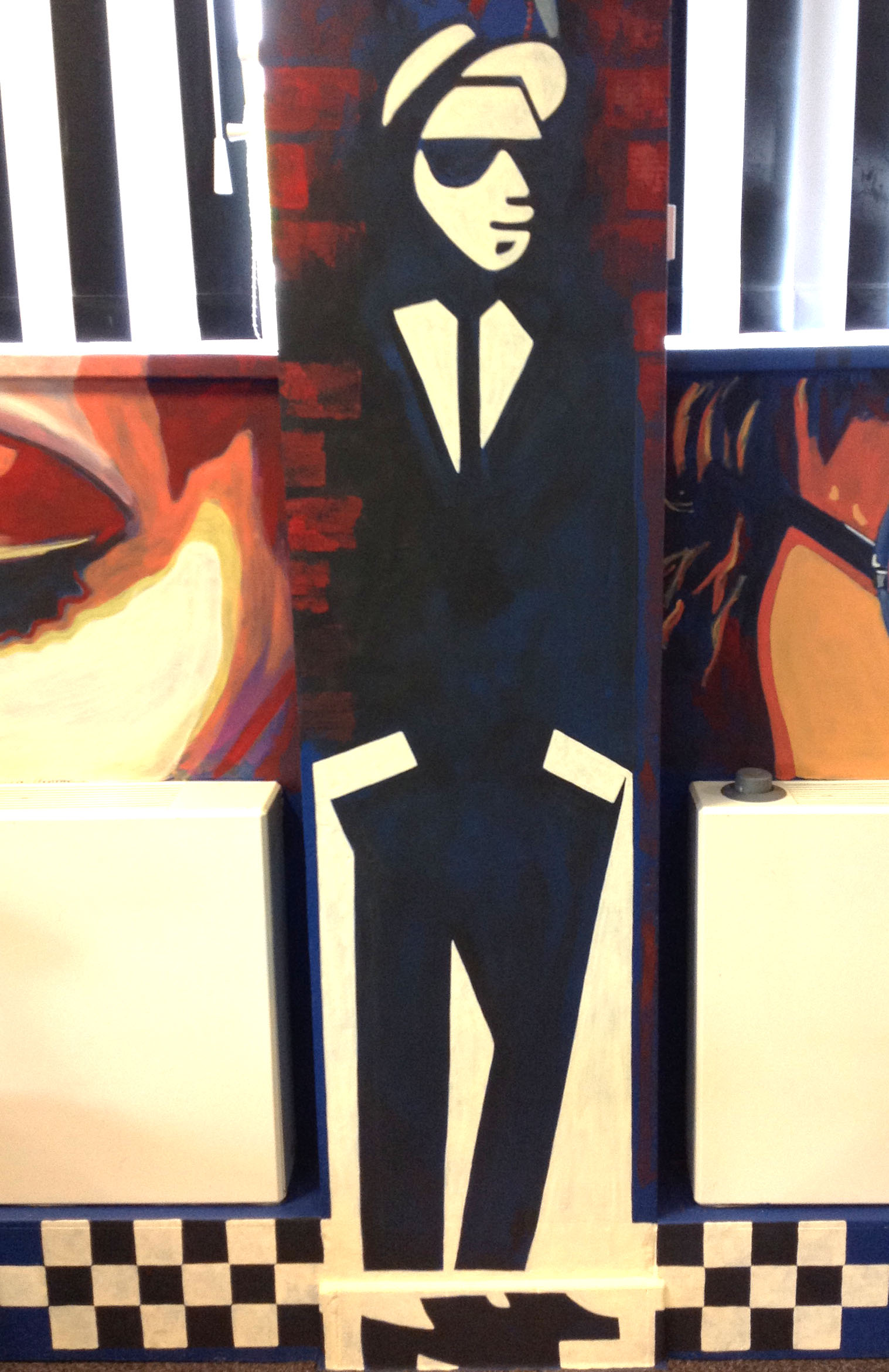
Early visuals saw the design take a variety of different layouts in order to discover how I might succeed in including as many genres of music as possible, hence the ‘Walt Jabsco‘ Two Tone and ‘M’ Motown record labels appeared and avoided the need to restrict the composition to individual portraits alone. As with making selections of individuals, record company logos could also have been added in abundance but I resisted the temptation to go further than these examples. Nevertheless, having said that, the images of Frank Sinatra and Louis Armstong were purposefully selected and combined in order that I could also create a visual pun. I wanted the position of Louis’ trumpet in relation to Frank’s ear to intimate the painting by Francis Barraud of Nipper the dog staring into a gramophone horn, which was the trademark of His Master’s Voice, a large British record label from the 1890’s.


Two Tone, an independent label set up by Jerry Dammers of The Special AKA in 1979, was a ska and reggae revival with an overtone of post punk energy. According to Dammers, anti-racism was intrinsic to the formation of the Specials, in that the band was formed with the goal of integrating black and white people. Many years later Dammers stated, “Music gets political when there are new ideas in music, …punk was innovative, so was ska, and that was why bands such as the Specials and the Clash could be political”. The very memorable logo was a collaborative design, Horace Panter created the 2Tone type stamp & Jerry Dammers added the black & white checks and designed the ‘Walt Jabsco’ figure I mentioned earlier. I don’t know who Walt Jabsco was, but I do remember Jerry wearing a bowling shirt with that name emblazoned on the back when we were at art school. Based in Detroit, Motown (Motor-Town) began as Tamla Records and successfully delivered a pop influenced style of soul music that played an important role in the racial integration of popular music.
( Two Tone The Specials – Too Much Too Young 1980)
( Motown The Temptations – Ball of Confusion 1971)





Awkward spaces such as that between the windows and heaters on the right hand wall encouraged the postioning of personalities who might be recognised by their eyes alone. In my naiivety I thought the spectacles of John Lennon, who was included for a second time as a solo artist, were very identifiable however I’ve since been proved wrong, I definitely didn’t foresee that he might be confused with Harry Potter! With music infused with a sense of spirituality Bob Marley popularised the reggae music of Jamaica to audiences around the globe, and his laid back stance at the microphone worked perfectly, and for that matter very appropriately, placed ‘high’ above one of the doors. Elvis Costello, as well as a choice in his own right was also included to represent the genre of New Wave, a development in style which links with the previous era of Punk Rock. Likewise the inclusion of Elton John and David Bowie (appearing as Aladdin Sane, the character he invented after killing off his previous alter ego Ziggy Stardust), pointed to a period of early to mid seventies Glam Rock as well as to themselves as individuals.
(John Lennon – Cold Turkey 1969)
(Bob Marley – I Shot The Sherrif 1975)
(Elvis Costello & The Attractions – Pump It Up 1978)
(Elton John – Bennie & The Jets 1974)

(David Bowie – Jean Genie 1973)
As a singer-songwriter, a poet with a guitar, Bob Dylan has been a significant influence upon other musicians for more than five decades. Songs from his 1963 Freewheelin’ album such as ‘Blowin’ in the Wind’ and ‘A Hard Rain’s Gonna Fall’, and in 1964 ‘The Times They Are A-Changin”, became anthems for a generation of young people fighting for civil rights, for anti-war movements and campaigns for nuclear disarmament.
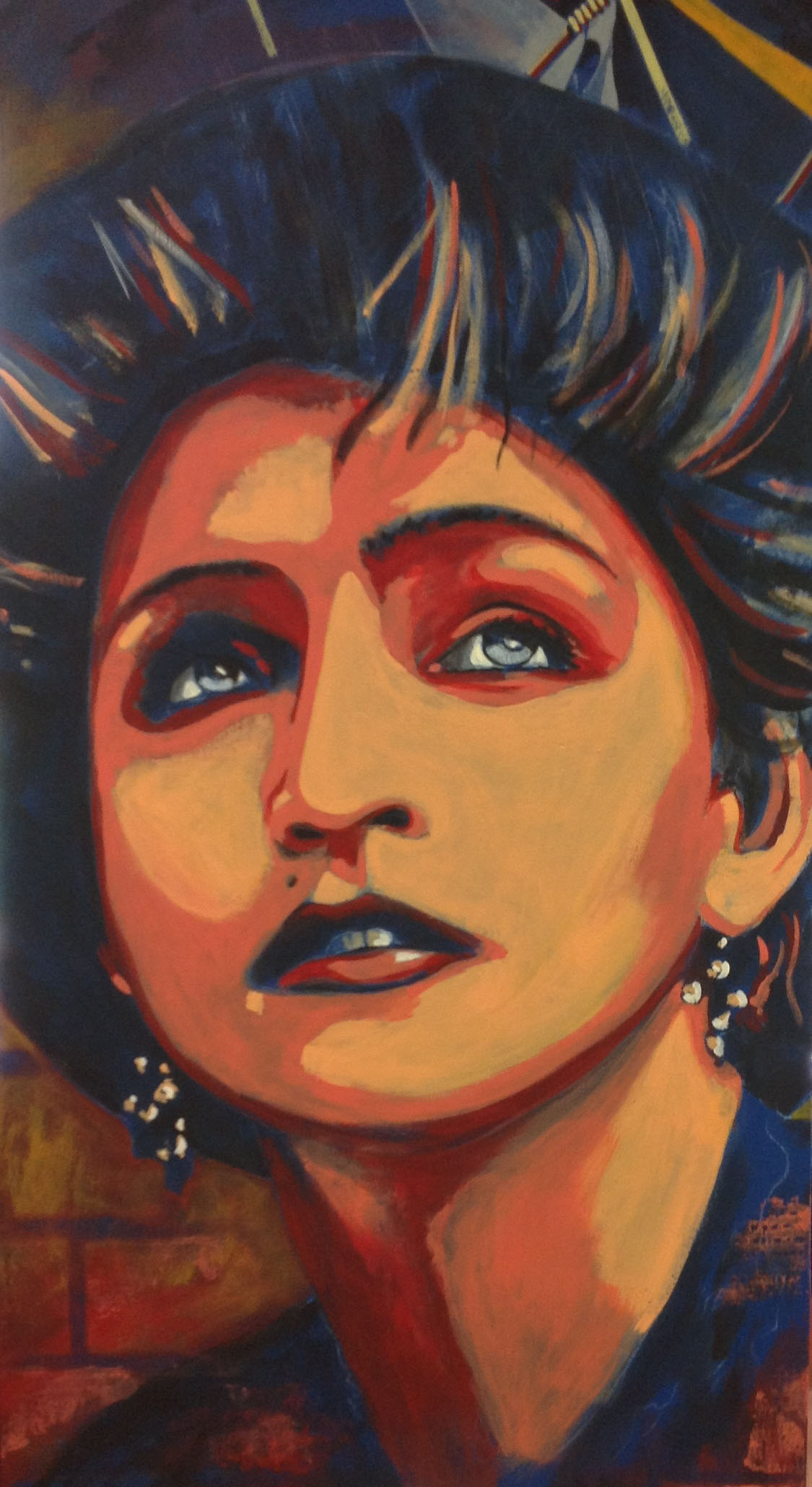
(Bob Dylan – The Times They Are A-Changin’ 1964)
Madonna has been successful both commercially and critically having sold more than 300 million records and has been listed as the best selling female recording artist of all time by Guinness World Records. Throughout her career she has written and produced most of her songs, and her inventive and sometimes controversial stage and music promo presentations reflect her original ambition of a career in modern dance.
(Madonna – Vogue 1990)

Although on my original shortlist I am embarrassed to admit that Freddie Mercury was a late addition, this section of wall having previously been reserved for Andrew Lloyd Webber because of his successful career as a composer for musical theatre. However, after he was reported to have flown back from New York to take his place in the House of Lords to vote with the government in support of tax credit cuts for the working poor (and he had only voted 30 times in 14 years despite having had 1,898 opportunities) he immediately fell out of favour and I washed him off! Freddie was therefore painted instead and I felt even more embarrassed for having excluded him in the first place. His presence as front man for Queen was like the appearance of a messiah and as a live performer in front of a stadium audience he surely has no equal.
(Queen – Radio GaGa – Live Aid, Wembley 1985)

I have only the greatest respect for Soviet composer and pianist Dmitri Shostakovich, whose career coincided with and was restricted by the iron rule of Josef Stalin. During Stalin’s reign the style of Socialist Realism was established for ‘the arts’ and any ‘revolutionary’ expression or experimentation was actively discouraged causing many artists of various disciplines to be purged. Shostakovich fell from official favour and was denounced on four occasions and was fortunate not to ‘disappear’ himself. Despite these restrictions placed upon his creativity and the constant fear he must have had for the lives of his family as well as his own, he produced symphonies, string quartets, works for piano, operas and film music that are both innovative and inventive.
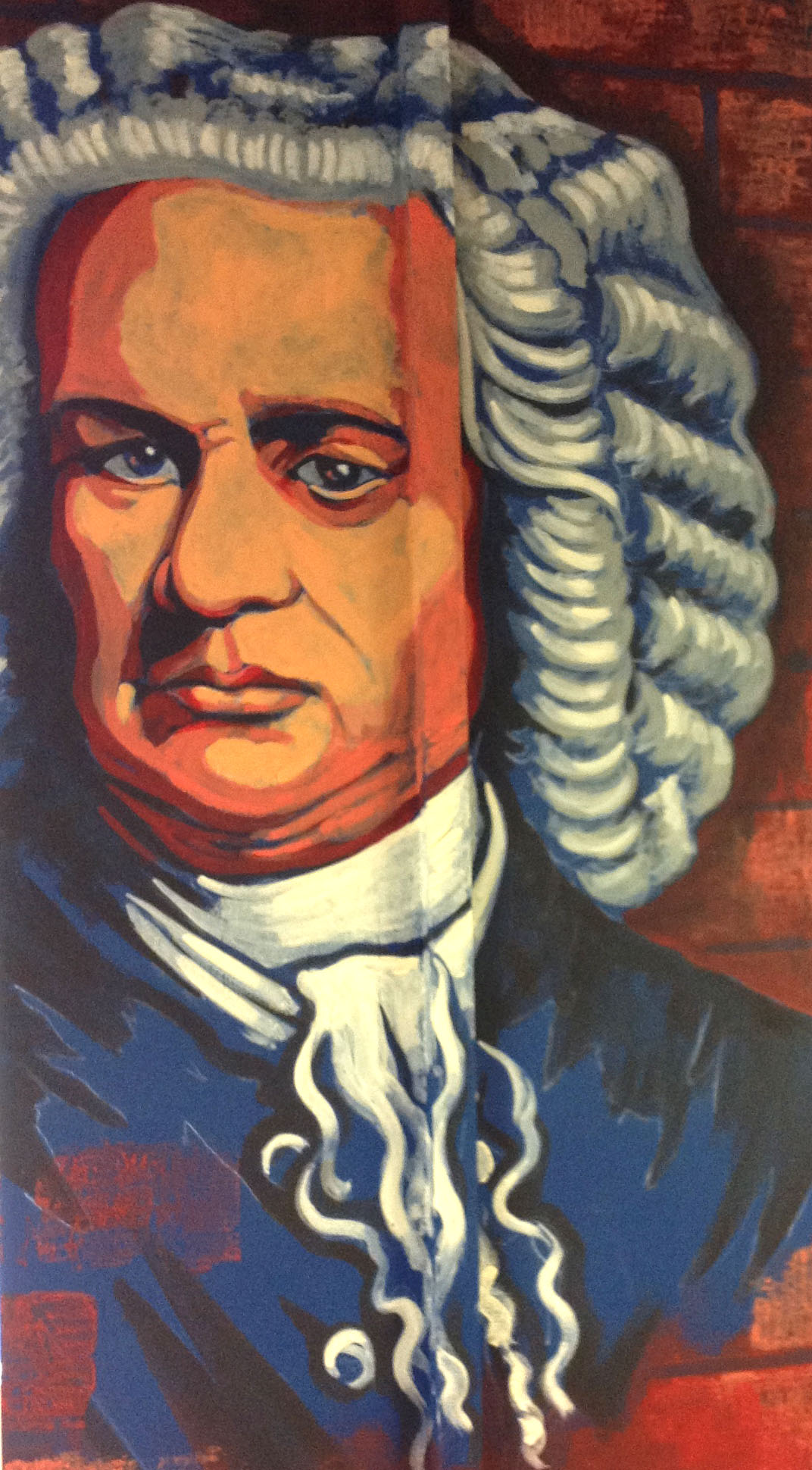
(Shostakovich – The Gadfly played by Nicola Benedetti – composed for The Gadfly film 1955)
Johann Sebastian Bach is considered one of the greatest composers of all time. He was productive in the extreme having produced Passions and oratorios, cantatas, a cappella music, keyboard music for organ, harpsichord and clavichord, orchestral and chamber music. His reputation and influence continues to grow as time has passed, his music ‘revered for its technical command, artistic beauty, and intellectual depth’. Many also consider him to be the father of jazz.
(Bach – Cello Suite No.1 – Prelude played by Yo-Yo Ma – composed between 1717 and 1723)

In recognising the voice as an instrument there could be no better examples than the operatic soprano tone of Maria Callas and the rich and warm laid back baritone of Frank Sinatra. They are both unique and unforgettable so I thought I’d place them to face each other. Whenever I hear Maria Callas sing I feel every hair on my body stand to attention, which is very odd because I don’t understand a word she’s saying! Nevertheless, it is impossible not feel the passion and expression in the projection of her voice. I don’t know of anyone else who can deliver such emotion, strength of feeling and sentiment simply through the words of a song. The first time I heard her sing ‘La Mamma Morta’ (‘They killed my mother’) I felt goosebumps run the entire length of my body, and the same has happened whenever I’ve heard it since, yet I hadn’t clue what the song was even about. ‘La Mamma Morta’ is from the opera ‘Andrea Chénier‘ by Umberto Giordano and Callas plays the part of Maddalena. In this aria she tells how her mother died protecting her during the turmoils of the French Revolution, and how her faithful servant (Bersi) had to sell herself as a prostitute in order to save Maddalena’s life. Tom Hanks gave a great description of it in the film Philadelphia. For anyone who feels that opera is not for them I’d encourage them to at least listen to this one aria with the voice of Maria Callas. It may well change your life!
(La Mamma Morta lyrics in English)
(Giordano – La Mamma Morta sung by Maria Callas – composed 1896)

There are many renowned personalities in the music industry who excelled despite their unprivileged childhood and the first in that category to be featured in the Cavern is Ray Charles. His mostly absent father worked on the railway, his mother was a sharecropper. When he was five years old not only did he begin losing his sight, his brother drowned in his mother’s laundry tub. He was completely blind by the age of seven and his mother died when he was fourteen. From these most humble of beginnings he ultimately combined rhythm and blues with gospel to pioneer a new style of soul music. In 2004 Jamie Foxx received an Academy Award for Best Actor for his role in the film ‘Ray‘, which was based on the musician’s life.
(Ray Charles – I Got A Woman 1958)
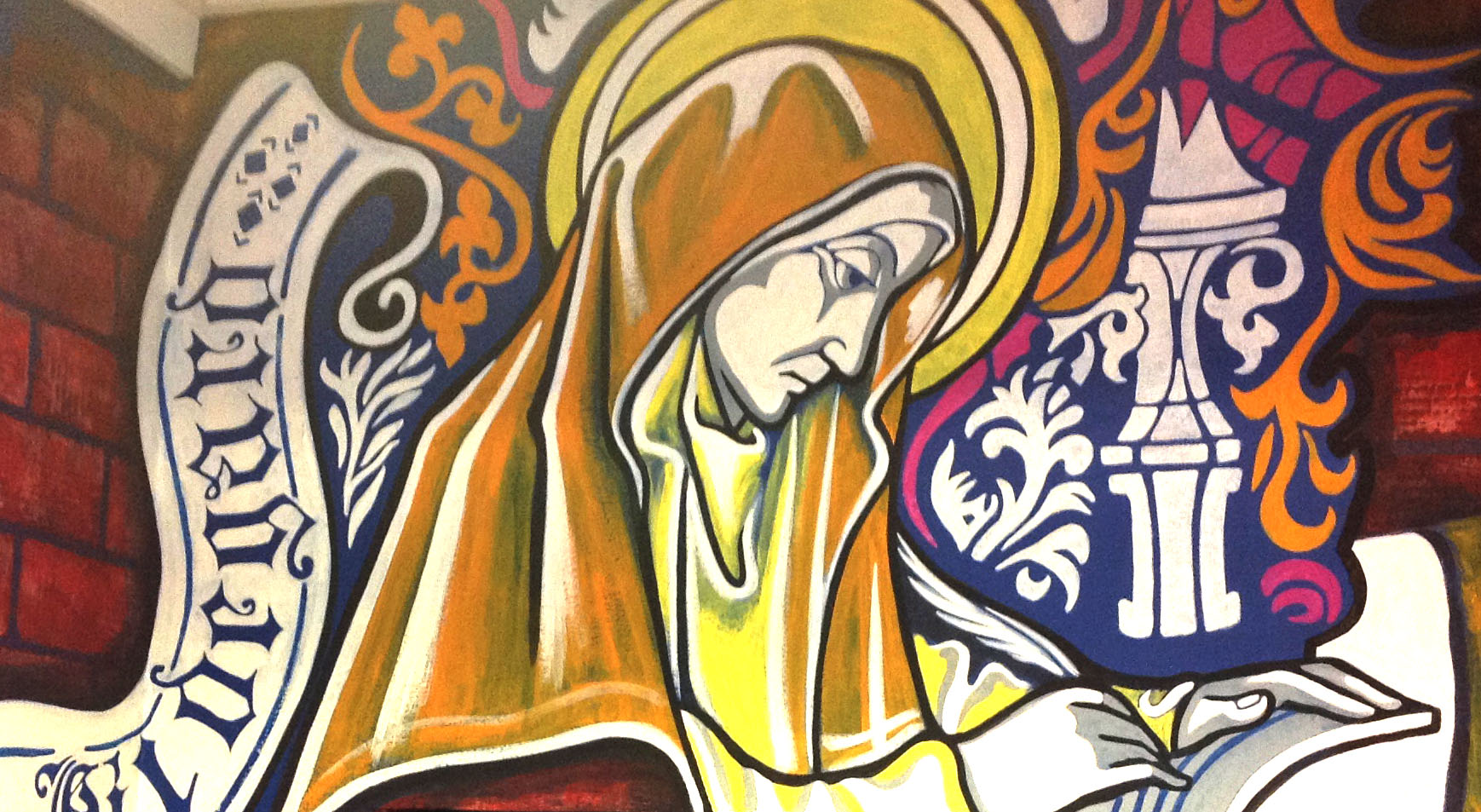
If we try to trace the earliest forms of music we have to look at the point at which something survives and that we can reproduce, which is the early days of plainsong from around 300AD consisting of a single unaccompanied melodic line. Much later than this, these daily and meandering remembered chants, which previously had a shared repertoire across Europe and the Middle East, were gradually tweaked and developed from one generation to another in oral fashion. By the time of the eleventh and twelfth century names begin appearing. Kassia of Constantinople (805/810 – before 865) is one example, an abbess who wrote Byzantian chant, whose scores can be interpreted by modern scholars and another is Hildegard von Bingen (1098 – 17 September 1179) an abbess who wrote poetry and also began combining voices and harmonies in very much the same way as a modern composer does. A composer of around 70 works, she is the first we have any significant information about.
(Hildegard – O virga ac diadema sung by the Kinder- u. Jugendchor der Katholischen Kirche Holzkirchen – composed between 1140 and 1179)

Hildegard’s image is taken from a restored stained glass window that was once part of the Rochuskapelle, just east of Bingen on the Rhine, and the light that would have shone through it works as a complete contrast and total opposite to the blackness surrounding the figure portrayed as the other ‘bookend’ on this wall. The Prince of Darkness is the nickname of Ozzy Osbourne of Black Sabbath, a hard rock band who incorporated occult and horror inspired themes in their dark and apocalyptic repertoire. As permanent resident of the Cavern and a lifelong fan, Ozzy’s inclusion was a special request by Phil Duff and his image taken from the cover of the Black Sabbath Volume 4 album.
(Black Sabbath – War Pigs 1970)

A quartet of classical composers take their place on the third wall, Wolfgang Amadeus Mozart is the largest and most dominating presence as might reflect his reputation and legacy. A prolific and influential composer his earliest works were written from the age of five and despite his early death wrote more than 600 works including symphonies, chamber music, opera and choral pieces. He is perhaps the most enduringly popular of classical composers.
(Mozart – Gran Partita 3rd movement Adagio played by Ensemble Zefiro – composed between 1781 and 1782)

A composer of the Renaissance William Byrd, a student of Thomas Tallis, has been described as perhaps Britain’s greatest. Though a Protestant in his youth his involvement with Catholicism became increasingly important and his commitment to this religion found expression in his motets, one of the pre-eminent polyphonic forms of Renaissance music.
(Byrd – Mass for Four Voices – Kyrie sung by The Tallis Scholars – composed early 1590’s)

Edward Elgar is one of the most distinguished of British composers. Among his best known works are the Enigma variations, the Pomp and Circumstance Marches, concertos for violin and cello, his symphonies and choral work such as The Dream of Gerontius. A lesser known fact is that he fell in love with football and is accredited with writing the first football chant, ‘He Banged the Leather for Goal‘ (whereas I thought it would have been ‘You’re going home in a horse drawn ambulance!’ Obviously I was wrong). He became such a devoted fan of Wolverhampton Wanderers he regularly cycled the 30 miles from Worcester to watch games during the 1890s.
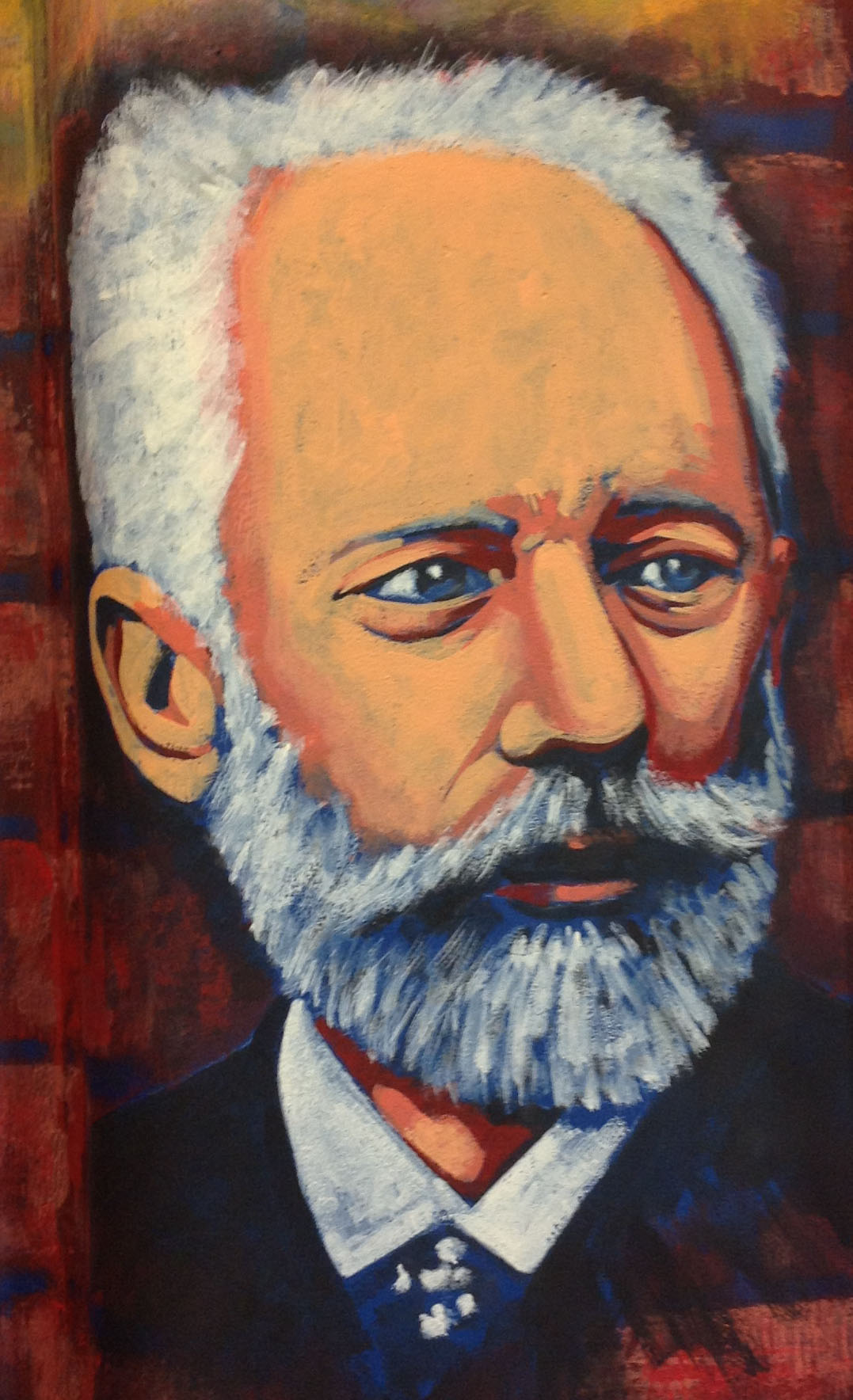
(Elgar – Enigma Variations – Variation IX (Adagio) ‘Nimrod’ played by London Symphony Orchestra conducted by Sir Colin Davis – composed between 1898 and 1899)
Some of the most popular music of the classical repertoire was written by Pyotr Ilyich Tchaikovsky, the first Russian composer whose music made a lasting impression internationally. If anyone was asked to name a ballet production, that list would almost certainly include The Nutcracker, Swan Lake and The Sleeping Beauty which are perhaps his most familiar works, along with his First Piano Concerto, the 1812 Overture and his Overture-Fantasy Romeo and Juliet.
(Tchaikovsky – Swan Lake Finale – composed between 1875 and 1876)
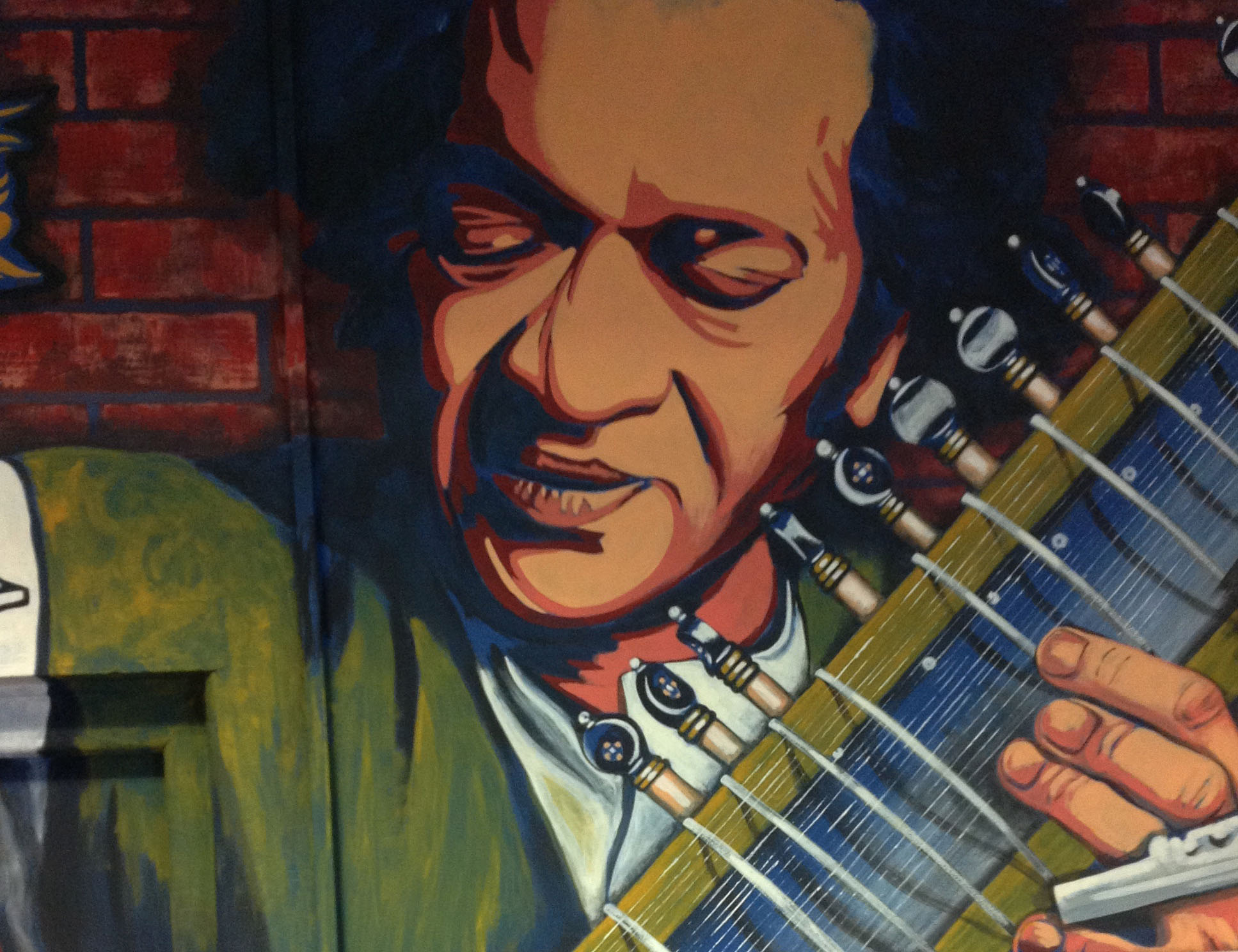
Above the portrait of Tchaikovsky and to the left of Byrd I included the large figure of Ravi Shankar to acknowledge an Asian tradition of music. In the fifties he toured Europe and America playing Indian classical music and engaged with western music, most notably through his relationship with concert violinist Yehudi Menuhin and The Beatles’ George Harrison. He was one of the best-known exponents of the sitar and influenced many other musicians throughout the world.
(Ravi Shankar – on the Dick Cavett Show 1971)
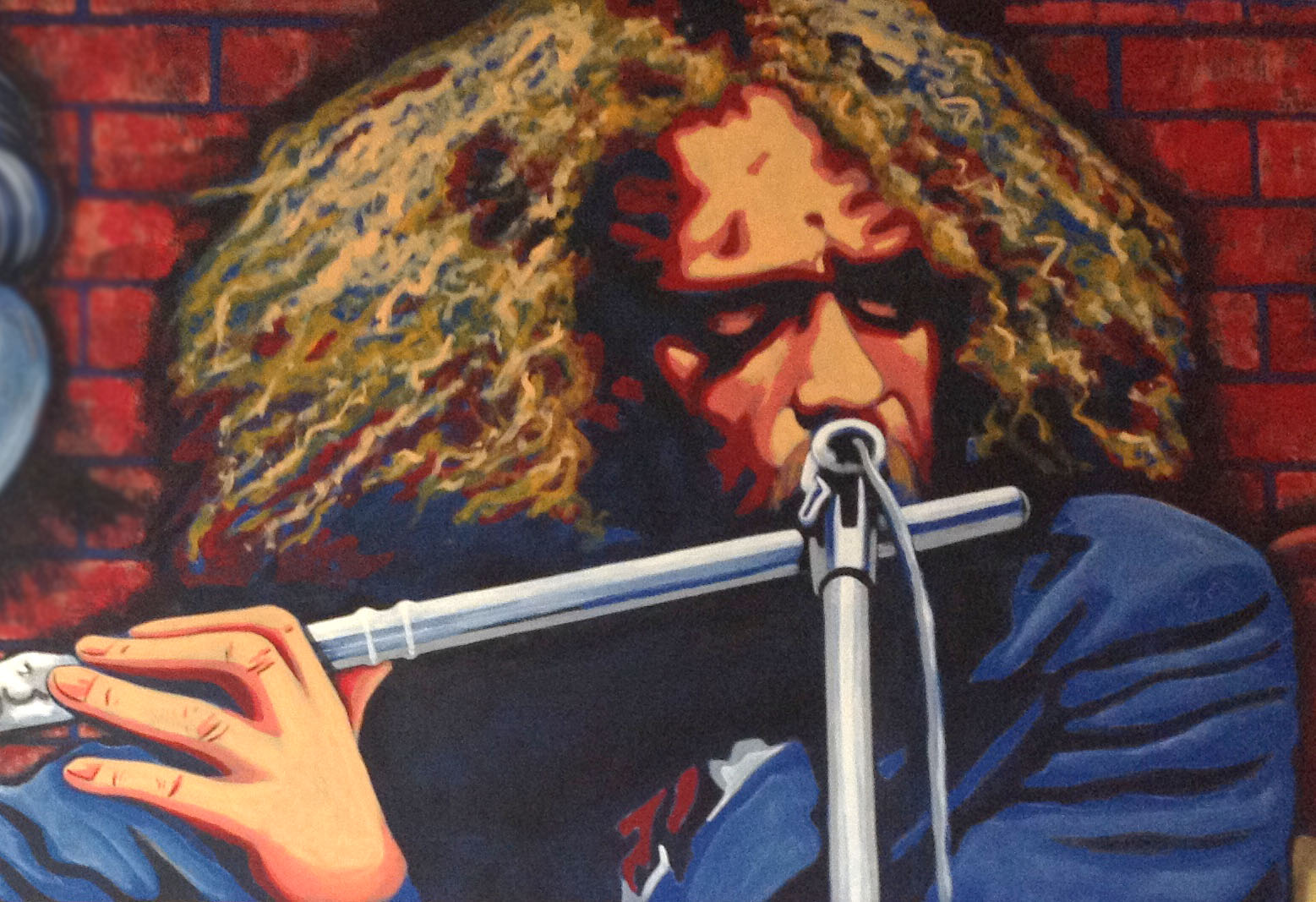
Named for no apparent reason after an 18th-century British agronomist who invented the machine drill for sowing seed, Jethro Tull was one of the most commercially successful and eccentric progressive-rock bands. They began as a blues-based band with some jazz and classical influences, and by the early 1970s had expanded into a full-blown classical-jazz-rock-progressive band which in the late 1970s turned toward folkish, mostly acoustic rock, all the while selling millions of albums and selling out worldwide tours. The large figure playing the flute is Jethro Tull’s driving force, Ian Anderson. With his shaggy mane, full beard and penchant for traditional tartan-plaid attire, Anderson acquired a reputation as a mad Faginesque character with his Olde English imagery and stage antics, like playing the flute or harmonica while hopping up and down on one leg. Although touring and recording as a band for over 40 years Ian Anderson no longer uses the Jethro Tull band name. Since 2012 he has toured and recorded music under his own name, but for all intents and purposes other than this name change, they are still a 5 piece band (with a guest singer) and their music is still very much ‘Jethro Tull’ – but without Martin Barre on lead guitar. The reason Tull have been included in this mural is simple. They are my favourite band and I’ve done the painting. So they’re in!
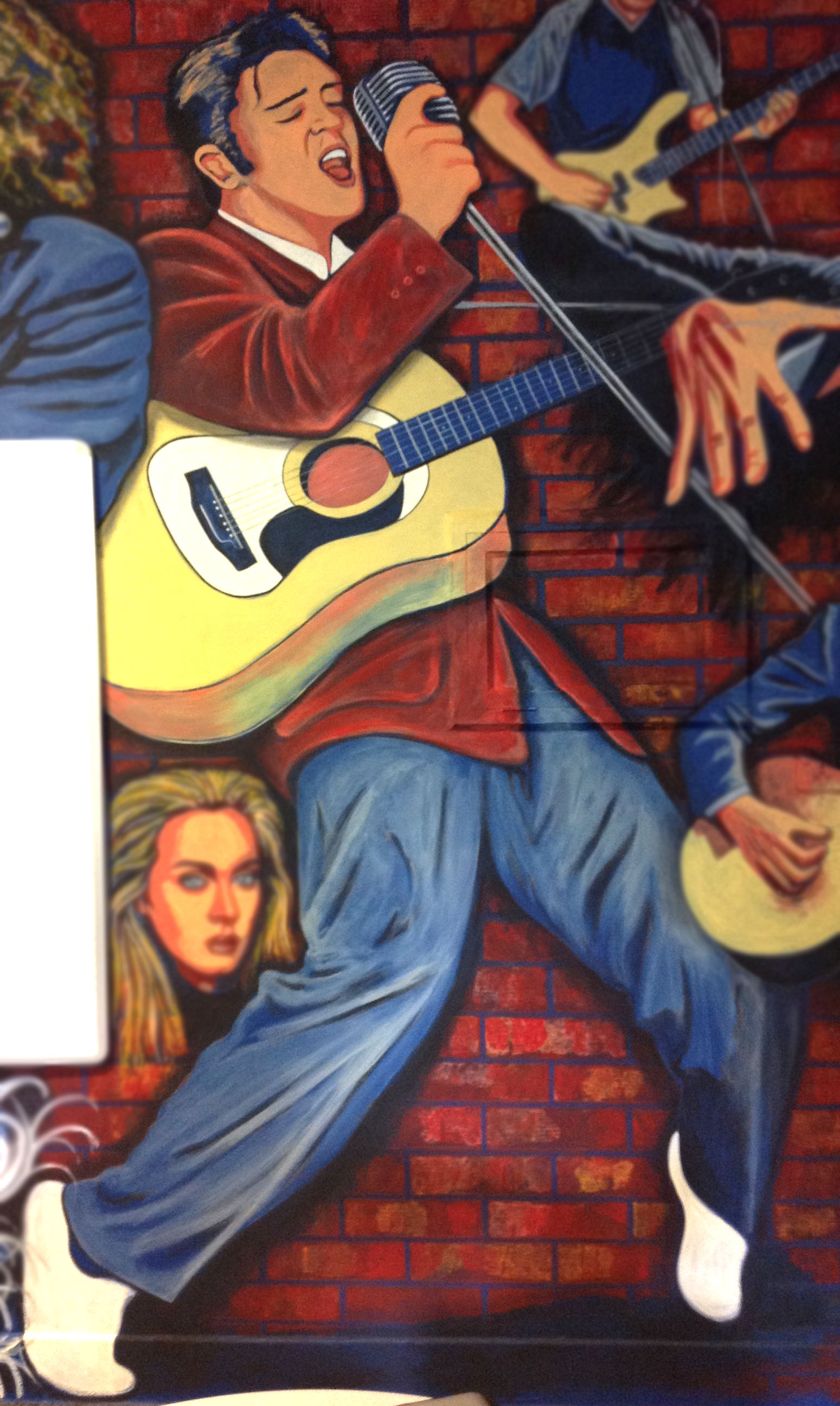
(Jethro Tull – A New Day Yesterday 1970)
The largest figure on this wall is a musical icon, the king of rock and roll, Elvis Presley. He began his career with the Sun Record label in 1954, in 1955 his recording contract was sold to RCA and by 1956 was an international sensation, and his unusual and provocative style ushered in a new era of American music and popular culture. He made films, television appearances, gave concert performances around the world and sold over one billion records. Known globally by his first name alone as well as simply ‘The King’, he was one of the most influential figures of twentieth century popular culture.
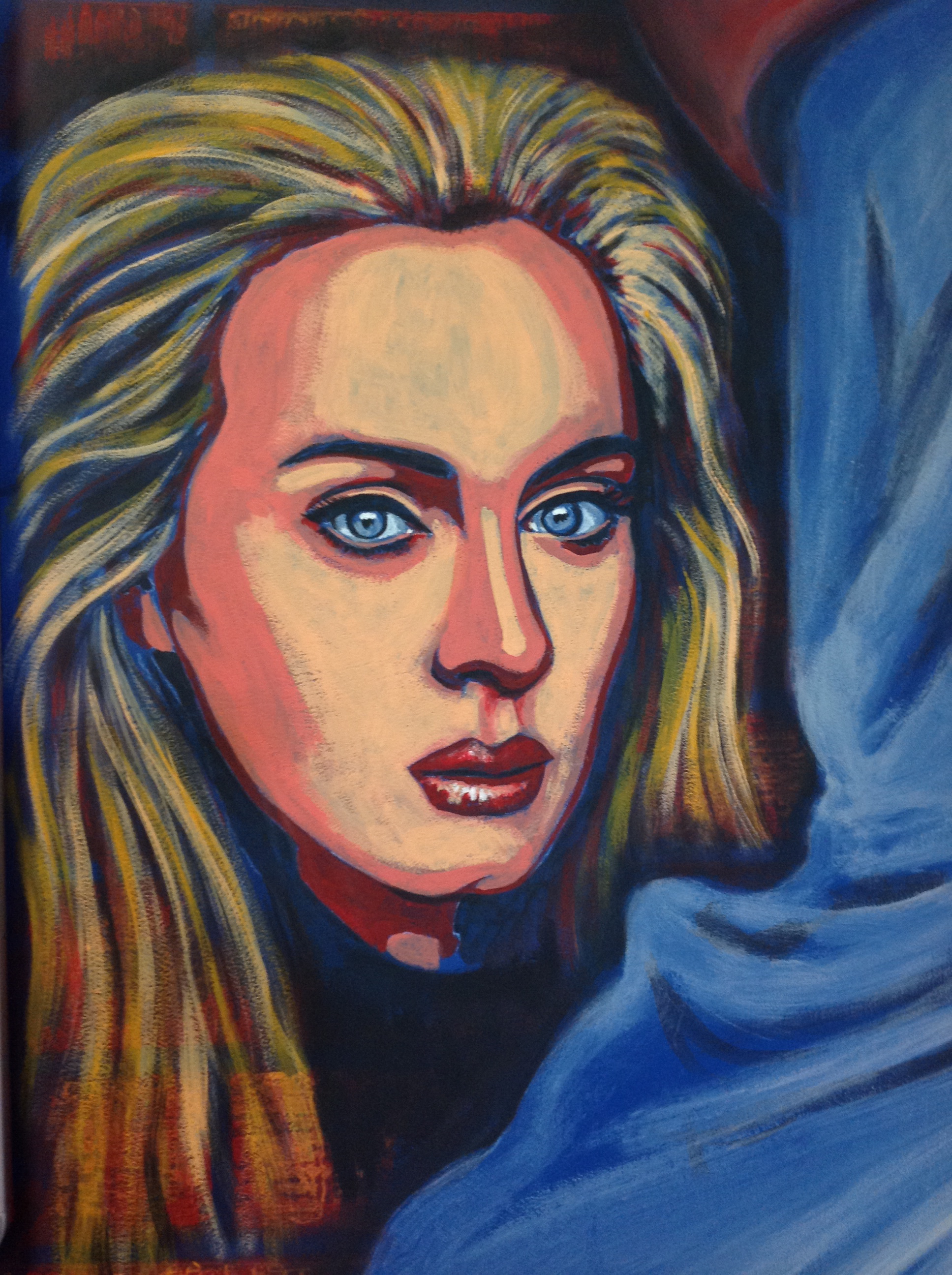
(Elvis Presley – Blue Suede Shoes 1956)
One of the best selling artists in the world today and likely to be the most recognisable face to children at the school is Adele. It is impossible to predict history while still in the present, but when Iain asked for the inclusion of an artist from today whose reputation might stand the test of time the most often suggested opinion was this singer and songwriter. She has already sold more than 100 million records, so we are not alone in presenting that opinion.
(Adele – Rolling In The Deep 2011)
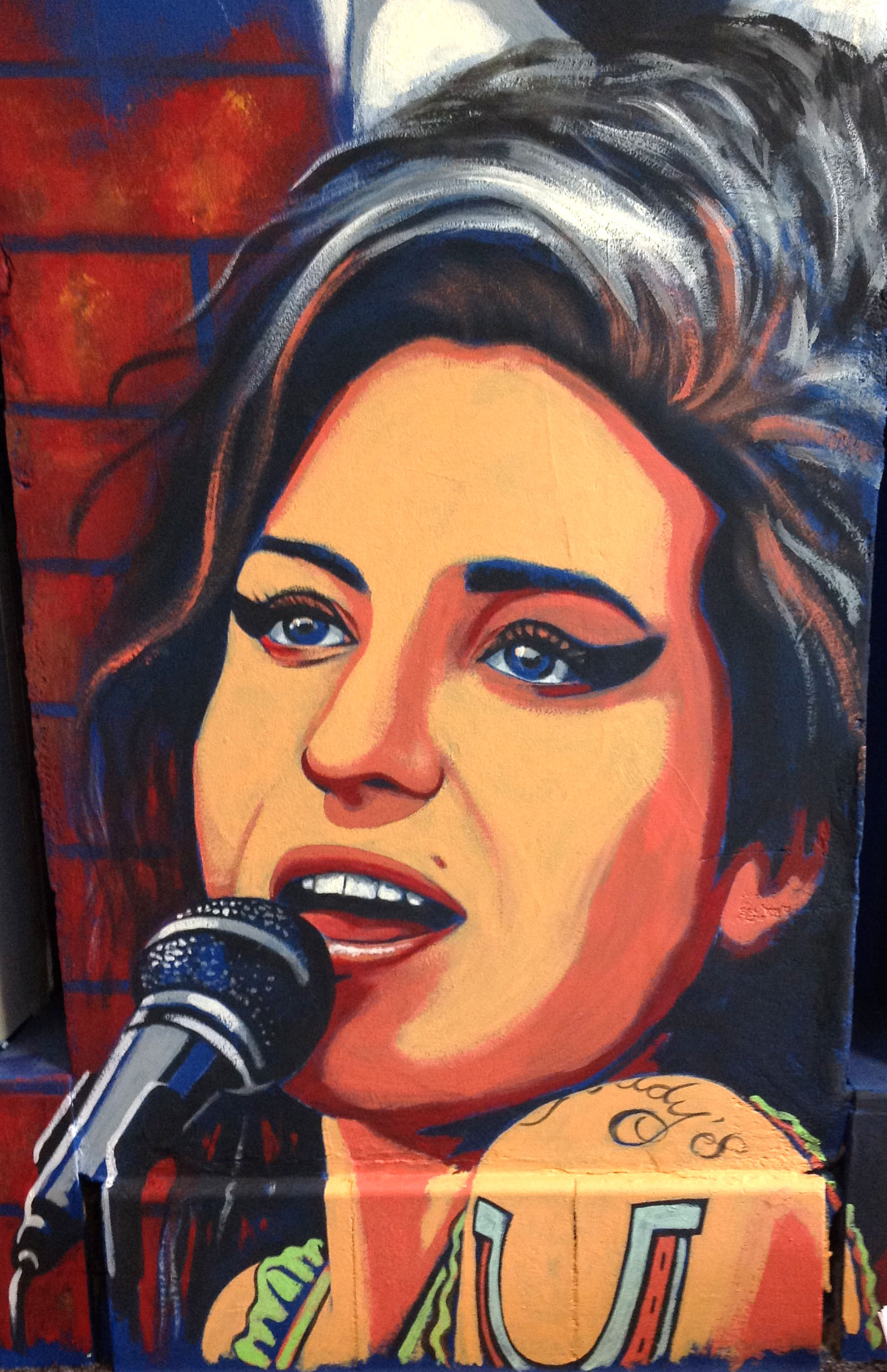
However, another artist from the recent present who achieved much in a tragically short career and whose reputation I’m certain will endure, was Amy Winehouse. Her powerful and individual vocal style was a mix of soul, rhythm & blues and jazz and following her well received debut album ‘Frank’ her second, ‘Back to Black‘, was awarded five Grammy Awards. Her ongoing mental health battles escalated as an ever-increasing furor of media attention invaded her career and her private life and insurmountable problems developed with heavy drug use and alcohol, which caused her early death aged 27. Her idol, singer Tony Bennett, described her as ‘an artist of immense proportions’ and George Michael as ‘the most soulful vocalist this country has ever seen’.
(Amy Winehouse – Back To Black 2006)
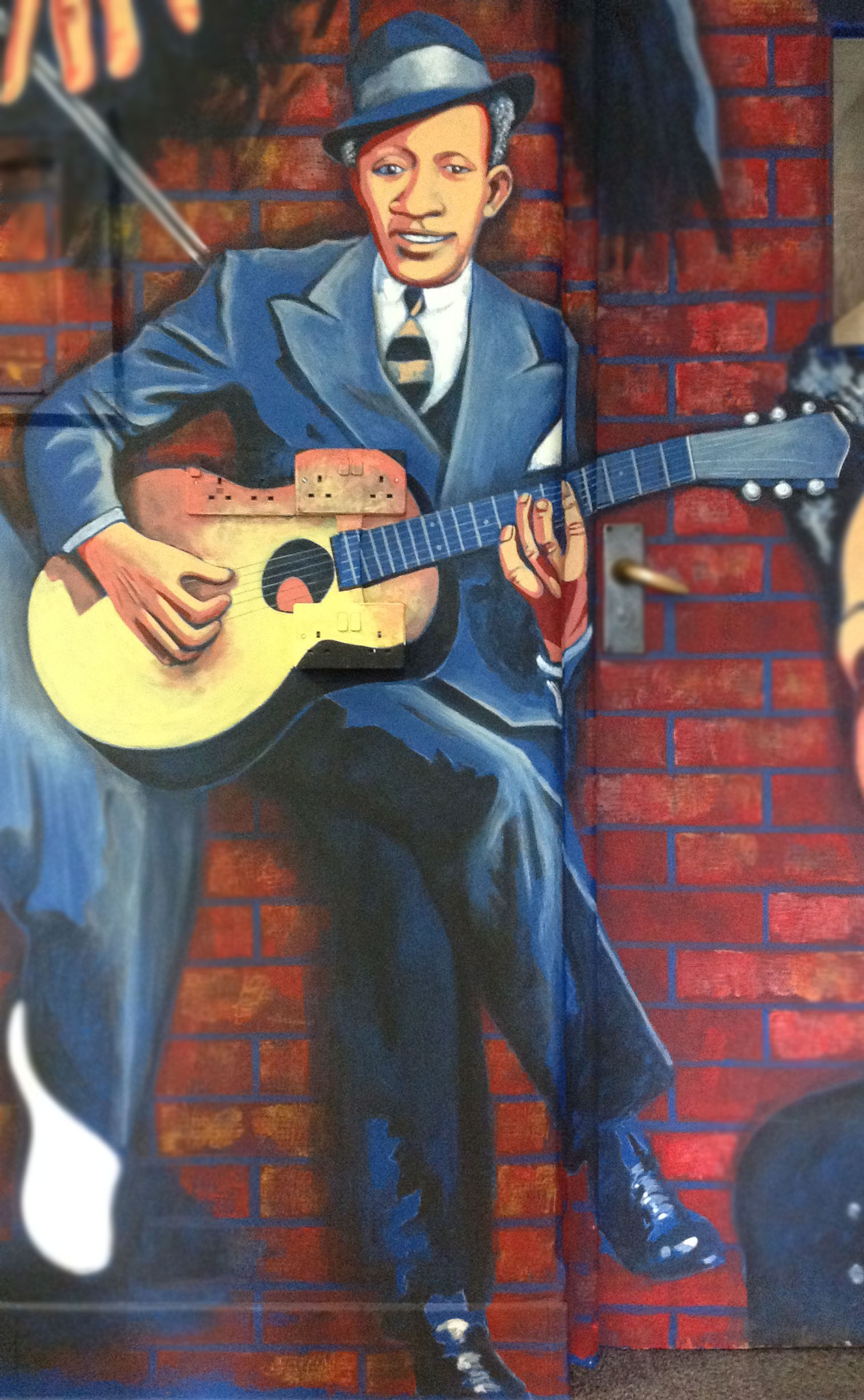
As far as legends are concerned, Robert Johnson‘s poorly documented life has given rise to many stories, such as his meeting with the devil at a crossroads where he sold his soul in order to become a great blues musician. In 2010 Rolling Stone magazine placed Johnson fifth in a list of ‘100 Greatest Guitarists of All Time’ and Eric Clapton has called him ‘the most important blues musician who ever lived’. In the Coen Brothers film ‘O Brother Where Art Though?‘ the Tommy Johnson character played by Chris Thomas King is based on Robert Johnson.
(Robert Johnson – Me & The Devil Blues played by Eric Clapton – composed 1937)
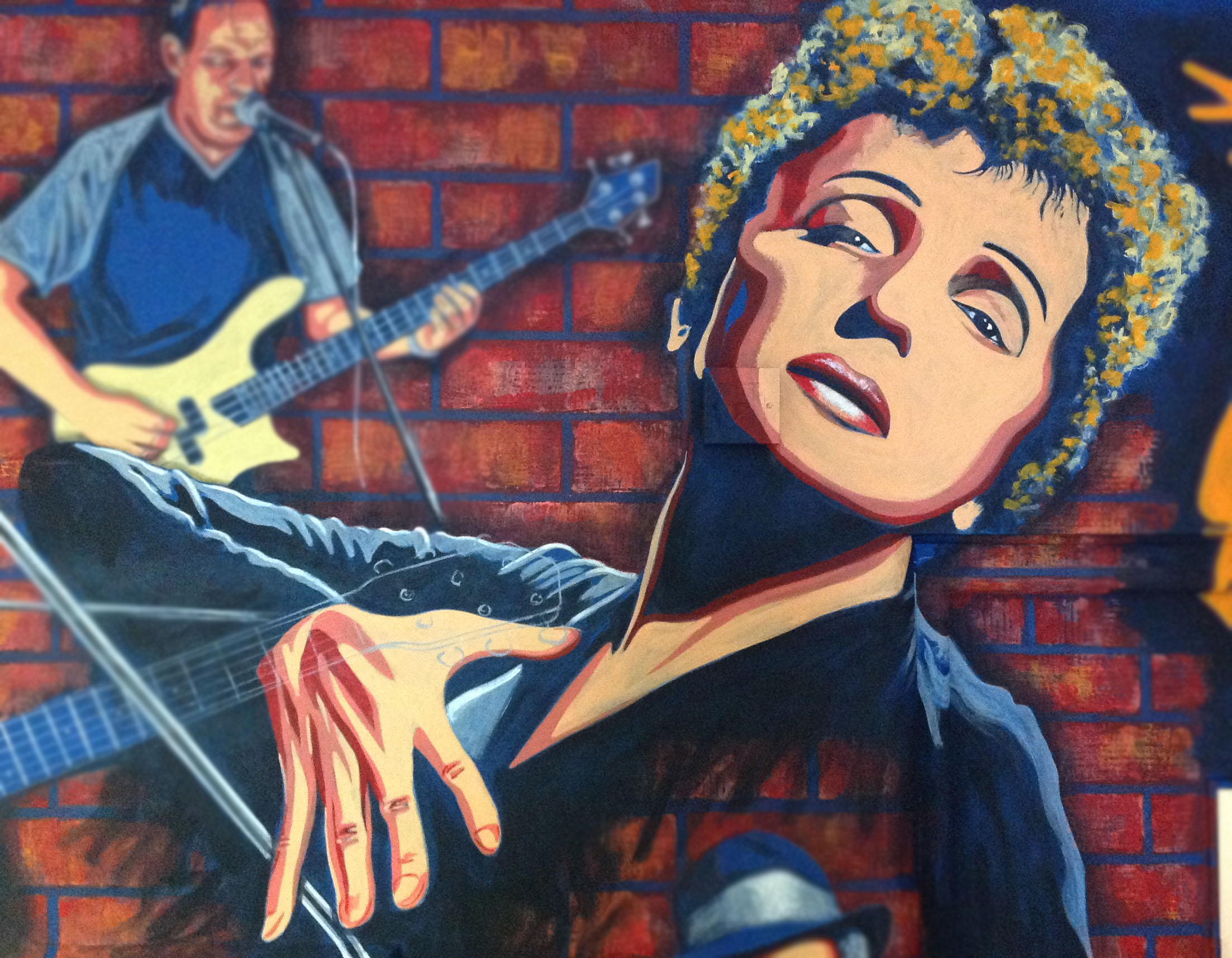
There is some speculation about the early life of Edith Piaf however legend has it that she was born on a Parisian pavement. Regardless, her mother abandoned her at birth and she lived with her maternal grandmother till her father took her to his mother, who ran a brothel and she was brought up by the prostitutes who worked there. At the age of 14 she became a performer, singing in the streets to earn money and when aged 19 was discovered by a night club owner. A nickname was coined from a combination of her height and a slang term for her name, La Môme Piaf, the Little Sparrow. A songwriter as well as a performer the subject of her songs reflected her life, such as ‘Non, je ne regrette rien’ (‘No, I regret nothing’) which was not written by her but was perhaps her most famous. Another, ‘La Vie en rose’ which can be translated as ‘Life Through Rose-Tinted Glasses’, was also the title of a 2007 biographical film for which Marion Cotillard won an Academy Award for Best Actress as Piaf.
(Edith Piaf – Non, je ne regrette rien 1959)
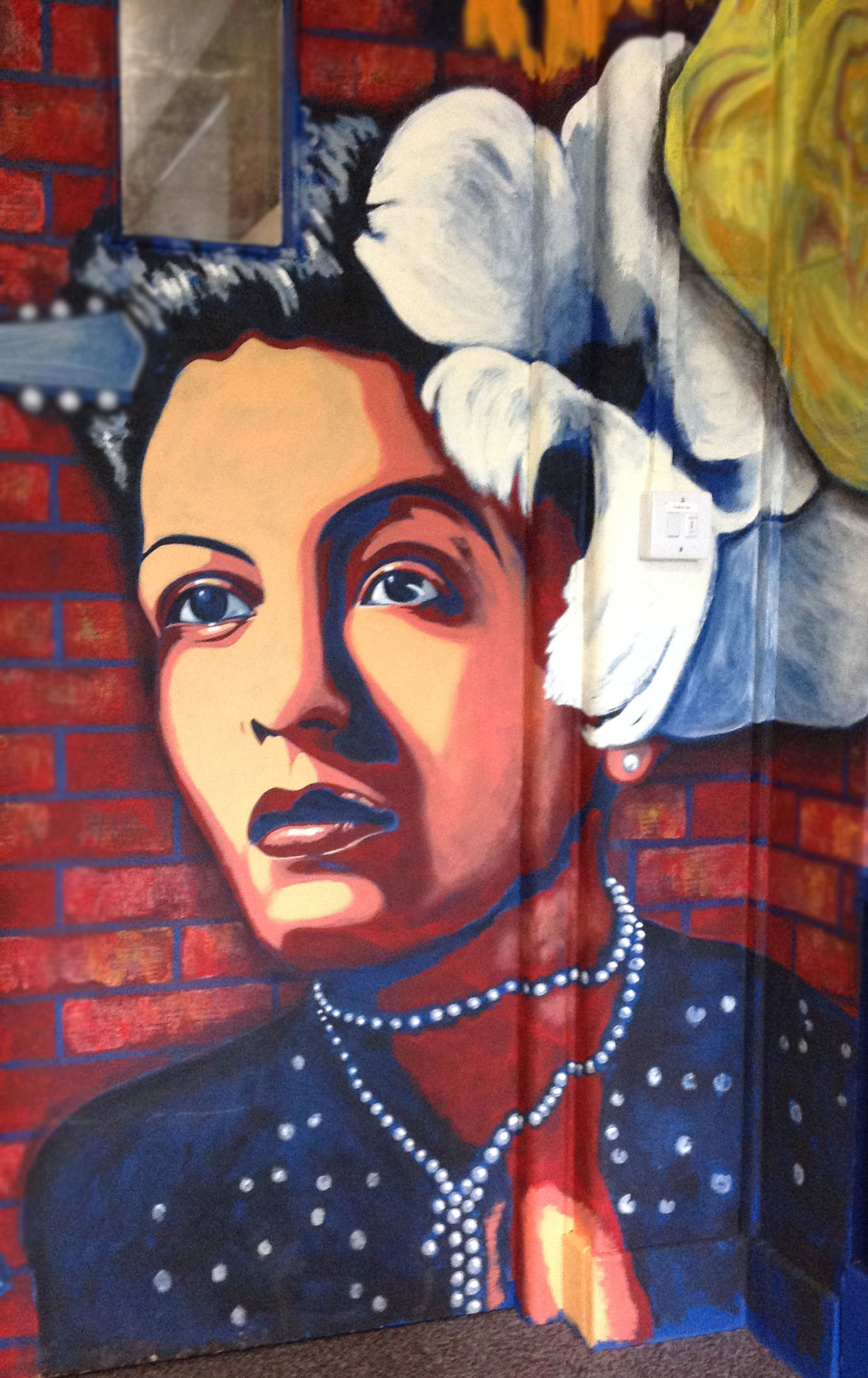
Like Piaf, Billie Holiday had a turbulent childhood. The daughter of an unmarried teenage couple she suffered from her parents’ absences and being left in the care of others and her frequent absence from school caused her to be sent to a reform school when aged 9. By the age of 11 she had dropped out of school completely. At age 12 a neighbour was arrested for attempting to rape her and later, with her mother now working as a prostitute, she also became one herself before she was 14, which eventually resulted in her being sent to prison and then to a workhouse. Her singing career began in night clubs in Harlem and she gradually pioneered a new vocal style. Following a succession of abusive relationships, legal problems and a prison sentence, bad health, alcohol and drug addiction, her life came to a premature end aged 44 from heart failure caused by cirrhosis of her liver.
(Billie Holiday & Louis Armstrong – The Blues Are Brewin from the film New Orleans 1947)
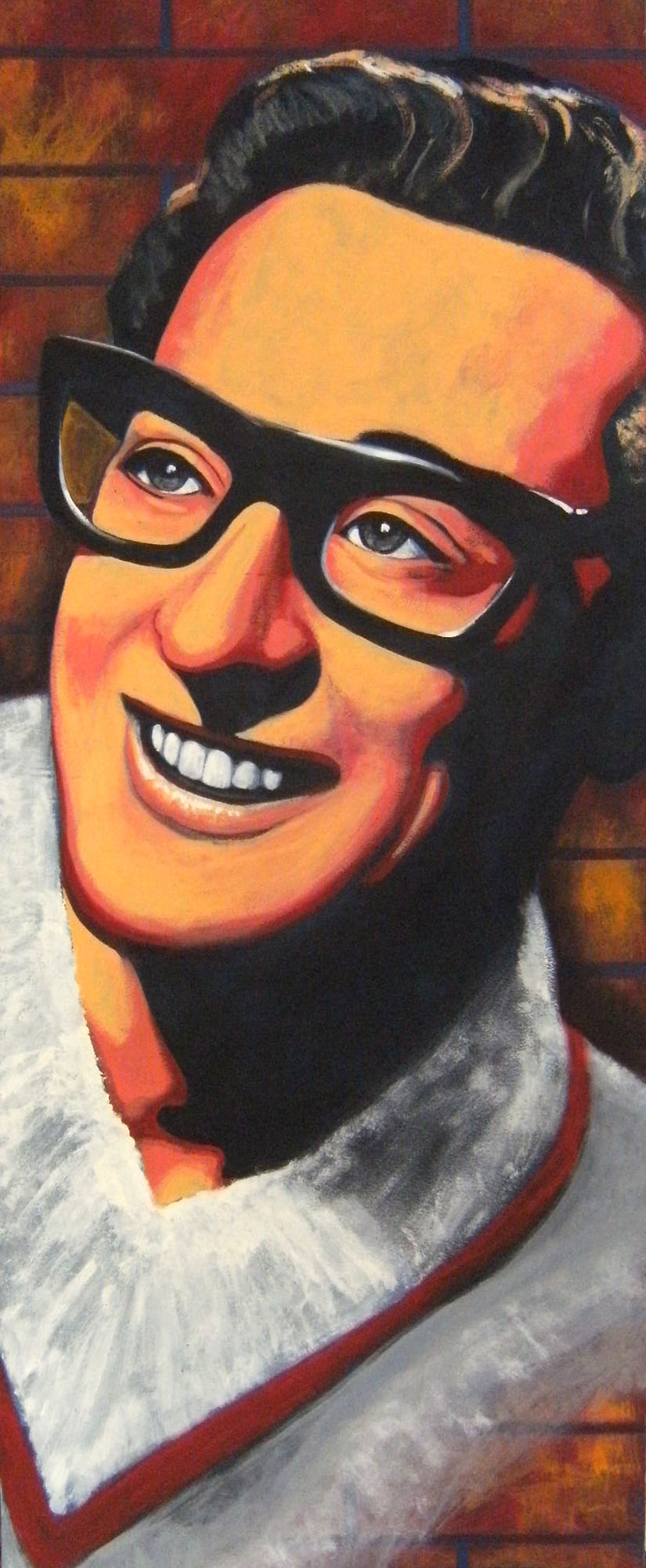
It is sad but an inescapable truth that so many of the creative artists portrayed within the room died young. A lifestyle of pressure and stress, personal insecurity or doubt of ones craft may have been the reason in some instances, temptation of alcohol and drugs being the cause of harm too. Damage to health that is deliberately self inflicted is not an uncommon occurrence. There are also those whose lives ended due to violence or through accident. Buddy Holly was only 22 years old when he died in a plane crash with fellow artists Richie Valens who was 17 and the Big Bopper (JP Richardson) aged 28. Despite his very short career he has been a major influence on later artists, including The Beatles. Holly’s untimely death is commemorated in Eddie Cochran’s ‘Three Stars‘ and most notably ‘American Pie‘ by Don McLean, the tragedy of February 3rd 1959 now remembered as ‘The Day the Music Died‘.
(Buddy Holly – Oh Boy his second and final appearance on the Ed Sullivan Show, 26th Jan 1958)

Crashes have claimed the lives of many artists, Eddie Cochran, Marc Bolan and most recently the band Viola Beach in car accidents, and in the air Otis Redding, Ricky Nelson, Jim Reeves, John Denver, Patsy Cline, Stevie Ray Vaughan, Jim Croce and members of the band Lynyrd Skynyrd to name just a few, but it was a plane’s disappearance in thick fog over the Channel that claimed the life of Glenn Miller, neither the plane or his body have ever been found. An arranger, composer and Big Band leader of the swing era he joined the army during WW2 at the peak of his career to form an army band, and his music was broadcast and performed to raise morale for the troops serving in Europe. In a radio broadcast Miller spoke about what he felt music might mean to people at that time, ‘America means freedom and there’s no expression of freedom quite so sincere as music’.
(Glenn Miller – Chattanooga Choo Choo from the film Sun Valley Serenade 1941)

I will always remember my 15th birthday, it was also the day Jimi Hendrix died. I was a particularly enthusiastic fan and it hit me as a terrific shock, he was another only 27 years of age. Jimi’s guitar playing was inventive, imaginative and at times outrageous, but definitely unique and distinctive. Though too young to see him in concert I’d witnessed his performances on TV at the Isle of Wight Festival and at the cinema in films such as Monterey Pop and Woodstock. As far as I was concerned Jimi was a phenomenon and tracks such as ‘Hey Joe’, ‘All Along the Watchtower’, ‘Foxy Lady’, ‘Purple Haze’, ‘The Wind Cries Mary’ and ‘Voodoo Chile’ are indelibly etched into the soundtrack of my teenage years.
(Jimi Hendrix – Purple Haze 1967)

Painted on the wall alongside Jimi is another giant, arguably the biggest of them all, Ludwig van Beethoven. Following in the wake of Mozart and despite increasing deafness he continued and developed that legacy, being responsible for a prodigious output: nine symphonies, thirty two piano sonatas, sixteen string quartets, the opera ‘Fidelio’ and the Missa Solemnis Mass. If the achievement of Ray Charles as a blind musician was impressive, then that of Beethoven is even more astounding. He was a conductor, virtuoso pianist and composer whose hearing began to deteriorate in his late twenties, and for the last decade of his life was totally deaf. In some accounts of his life it has been recorded that his last words were ‘Plaudite, amici, comedia finita est’ (‘Applaud, my friends, the comedy is over’), however others have suggested they were, ‘I shall hear in heaven’. I prefer the latter.
(Beethoven – 5th Symphony 1st movement Allegro con brio played by Chamber Orchestra of Europe conducted by Nikolaus Harnoncourt – composed between 1804 and 1808)

As I have already mentioned, I placed Frank Sinatra and Maria Callas directly opposite each other. Their instrument was their voice and although they were two very different singers both were distinctive and timeless. Frank Sinatra was one of the most popular and influential musical artists of the 20th century, his career began in the swing era of the 1930’s and continued for over 60 years. Although he ‘retired’ in 1971, there were another thousand concerts after that and he is one of the best selling artists of all time. In his prime his laid back lazy baritone voice was full, silky smooth and absolutely one of a kind. As a song-stylist who marked the beginning of an era that made the vocalist the focus and not the bandleader and his band, there is no-one who can bear comparison with Ol’ Blue Eyes!
(Frank Sinatra – I Get A Kick Out Of You from The Frank Sinatra Show 1957-1958)

Louis Armstrong was one of the most important and influential musicians in the history of jazz yet his childhood in New Orleans, spent in an area known as ‘the battlefield’, was poverty stricken and his grandparents had been slaves. When he was a boy dancing for pennies in the street he would scoop up the coins and put them in his mouth for safekeeping, and was given the nickname Satchelmouth, which was then shortened to Satchmo. He learned how to play the cornet after being sent to a reform school which was where he first played in a band. Following his release aged 14 he worked odd jobs before performing with local bands and then on steamboats on the Mississippi river, which he described as ‘like going to university‘. Eventually working in Chicago he developed a vocal style delivered in his individual throaty manner and was also the inventor of scat singing after he dropped his sheet music during a recording session and couldn’t remember the lyrics. As an African-American living in a segregated society he gained access to things usually denied those with his skin colour and he was criticised for not taking a strong enough stance within the Civil Rights Movement. Although he did have strong political views they were rarely aired publicly, feeling that he would become a target. ‘My life is my music. They would beat me on the mouth if I marched, and without my mouth I wouldn’t be able to blow my horn … they would beat Jesus if he was black and marched’.
(Louis Armstrong – Basin Street Blues from the Bell Telephone Hour: The American Song, 2nd Feb 1964)
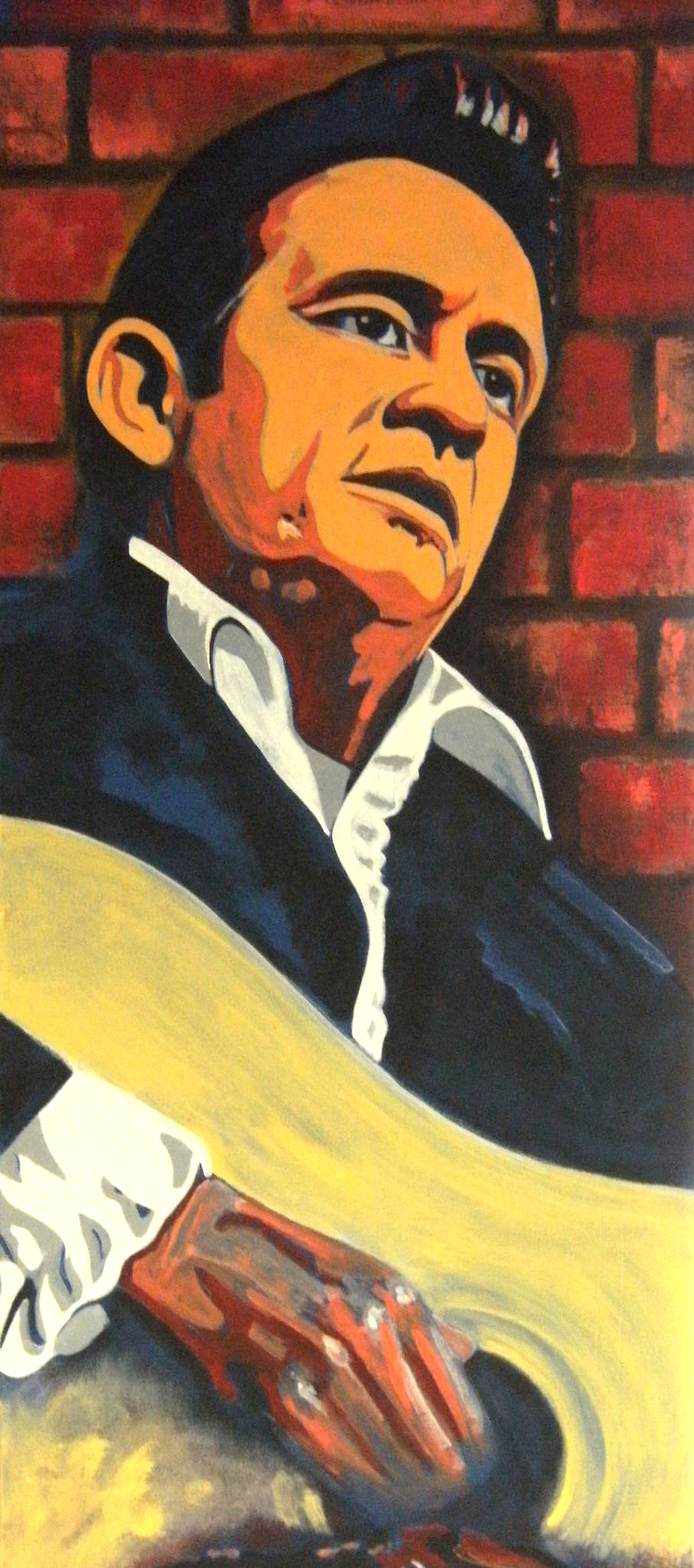
With an instantly recognisable bass baritone voice, Johnny Cash, the ‘Man in Black’, successfully combined country, rockabilly, blues, folk and gospel music into a unique blend. A biographical film ‘Walk the Line‘, released in 2005, with a convincing Joaquin Phoenix taking the role of Cash and Reese Witherspoon as June Carter (for which she won an Academy Award for Best Actress), chronicled his early life to his rise to fame with Sun Records in Memphis, his relationship with country singer June Carter, his unpredictable behaviour due to his drug addiction and the fan mail received from prison inmates which inspired him to perform a concert in Folsom Prison. One of his most memorable and earliest songs (and my favourite), is ‘Folsom Prison Blues’, which includes the chilling line ‘But I shot a man in Reno, just to watch him die’. It was recorded in 1955, a haunting folk-style ballad about which Cash said, ‘I sat with my pen in my hand, trying to think up the worst reason a person could have for killing another person, and that’s what came to mind’.
(Johnny Cash – Folsom Prison Blues 1969)
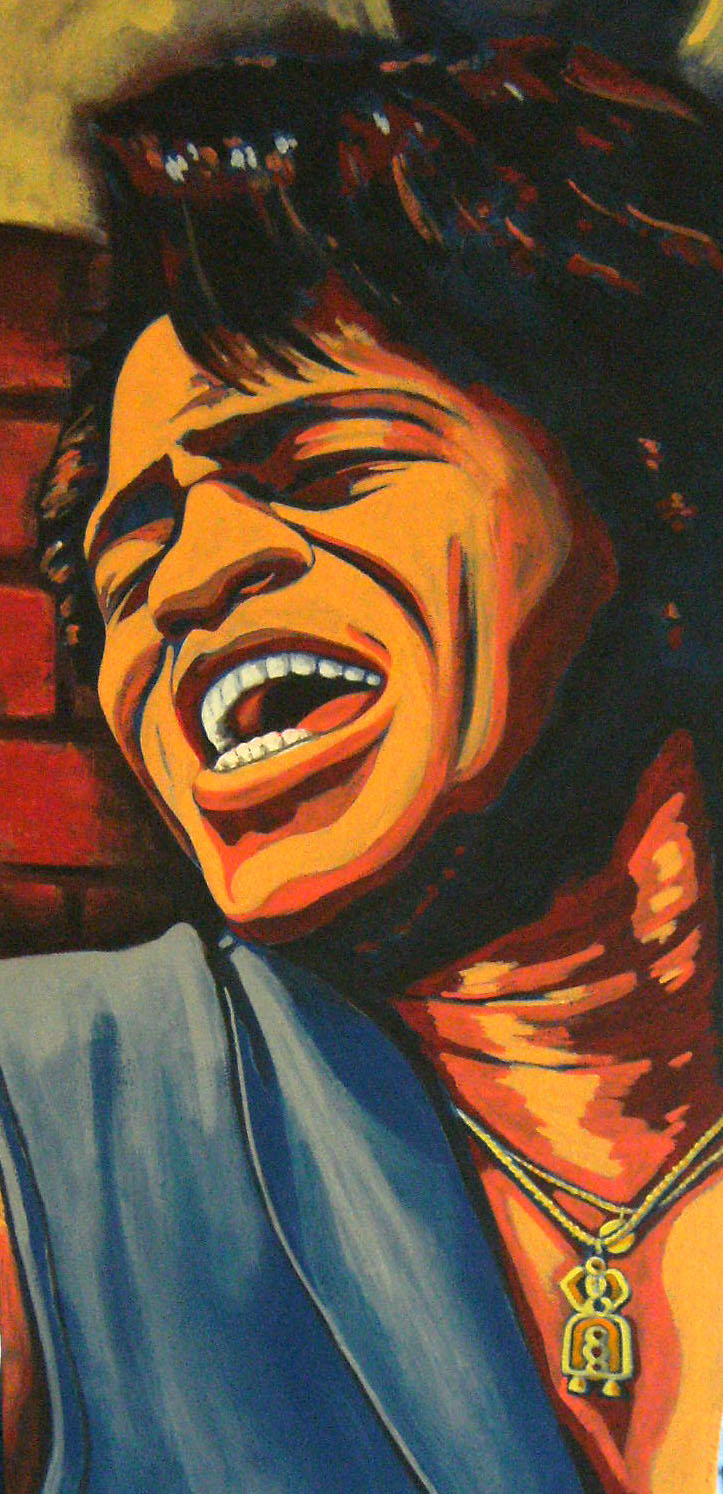
Known for his turbulent personal life as well as his social activism, both in his songwriting in songs such as ‘America is My Home’ and ‘Black and Proud’, and advocating the benefits of education to schoolchildren James Brown was born in a one-room shack in the woods of Barnwell, South Carolina. Growing up in abject poverty during the Great Depression, he danced for pennies, picked cotton, washed cars and shined shoes. At the age of 16, he was arrested for stealing a car and sentenced to three years in prison. While in jail he organised a prison gospel choir and met Bobby Byrd, an R&B singer and pianist, forming a friendship and musical partnership that proved one of the most fruitful in music history. James Brown is unquestionably one of the most influential musical pioneers of the last half-century. The Godfather of Soul, the inventor of funk, the grandfather of hip-hop, he is cited as an influence by artists ranging from Mick Jagger to Michael Jackson to Afrika Bambaataa to Jay-Z. Brown wrote in his memoir, ‘Others may have followed in my wake, but I was the one who turned racist minstrelsy into black soul—and by doing so, became a cultural force’.
(James Brown – I Feel Good 1966)
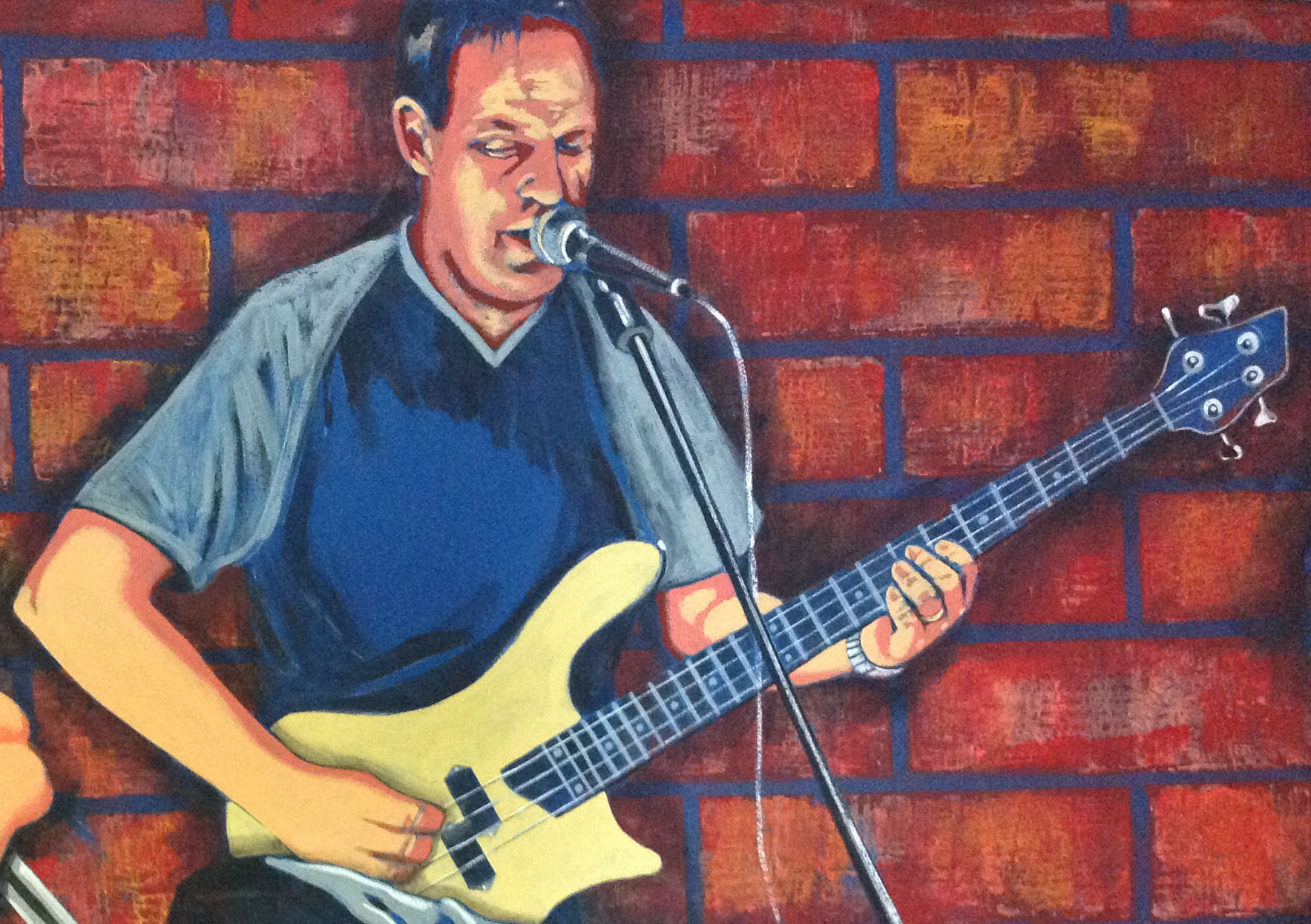
There is one figure left to describe but unless you keep a watchful eye on the listings of bands playing the Peterborough pub circuit, are an employee of Fulbridge Academy or a personal friend of Mr Phil Duff, it is perhaps unlikely you would have heard of the titanic rock trio that is 3 Parts Dirt! While I’ve been daubing the Cavern walls with paint I’ve not only been a witness to the entertaining and imaginative music lessons Phil has delivered but also of his determination to master works by Mozart, Beethoven, Bach, Haydn, Brahms, Chopin, Percy Grainger and Cécile Chaminade on his piano too. In addition, I’ve been introduced to and become an addicted groupie of his rock band 3 Parts Dirt! who play Phil’s original compositions. He’s a very talented man and I’d encourage everyone to get connected to the 3 Parts Dirt! Facebook page and keep informed of upcoming gigs. Believe me, you won’t be disappointed, just read this review of their recent gig at The Angel Inn in ‘Rowdy Oundle’. If there’s any justice in the world, 3 Parts Dirt! will be invited to appear in the next series of ‘Later………with Jools Holland’.
(3 Parts Dirt! Selfish Everything And Nothing Drinking In The Sun Old Codger)
So, the Cavern music room project has reached it’s conclusion. What more is there left to say other than a big ‘Thank You’ to Iain Erskine for the invitation and the opportunity to be involved with such a fantastic project, it’s been an absolute pleasure to work at Fulbridge again.
Lastly, I must also say a big ‘Thanks’ to Phil Duff for allowing me to take temporary residence in his room for the last 70 days. Being in Phil’s company has been like reliving my art school days again. It’s been a laugh a minute and to paraphrase a familiar Led Zep song, it reeeeeeally has been a ‘Whole Lotta Fun’!!!



Fulbridge Academy, Keeton Rd, Peterborough PE1 3JQ

Leave a Reply